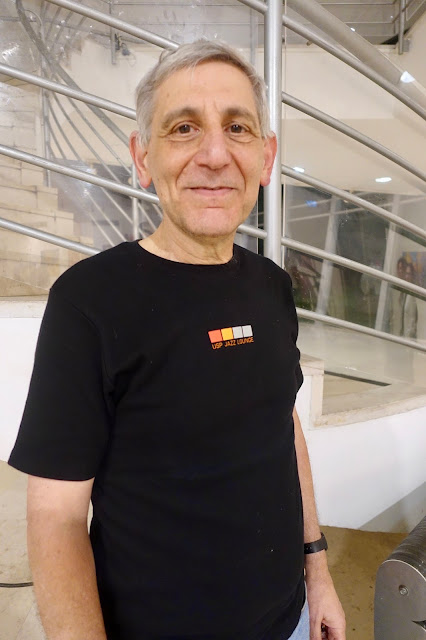I last visited Bulgaria in 1986. That's 31 years ago. My daughter was just two years old. She now has three children of her own, the youngest older than she was then. The country still had a communist regime. The restaurants had lengthy menus but most of the items listed were not available and choice was limited to something called 'kavarna" - a watery stew and the famous Shopska salad with its salty white cheese. We ate lots of pizza purchased at a stall in the street as well as delicious fresh plums and apples being sold by elderly women at the side of the road. "Corecon" shops sold what were termed "luxury goods" consisting mainly of poor quality chocolate, cigarettes and drink purchasable only by tourists with foreign currency.
 |
| Alexander Nevsky Cathedral, Sofia. |
There was constant pressure to change money at amazingly advantageous black-market rates but as there was so little to spend it on, taking the risk seemed pointless. This didn't deter the touts although telling them we were carrying Irish currency seemed to do the trick, producing a contemptuous response but peace at last. I have memories of clean beaches with plenty of space and an old lady who came every two days to clean our chalet and to change the towels. She was very taken with my daughter and brought her treats of fruit or nuts each time she came which were shyly accepted and then devoured.
I returned this year, due mainly to having discovered that Bulgaria has a large collection of modernist buildings from the 1930's and 40's and I have written separately about this
here. In 1986, I spent most of my time in what was then the quiet seaside resort of Sunny Beach, now, I am told, massively over developed and flooded by young visitors from Western Europe each summer. I recall days trips to Varna, Sozopol and Burgas but not a great deal about what I saw there. Well, it was a long time ago and I had a two year old to entertain.
Bulgaria in 2017 is a very different place. The communist regime fell in 1989 and the country slowly liberalised, opening up to private enterprise before joining the European Union in 2007. Today, Sofia, Plovdiv and Varna offer the range and quality of cultural activity available in similar sized cities across Europe. There are many good quality restaurants offering local and international menus and although there is still poverty it is not as obvious as it was in 1986. In 2019, Plovdiv has a fantastic opportunity to show off its cultural splendours as it has been selected European Capital of Culture for the year. I spent three days in that city and have already written about its delights
here.
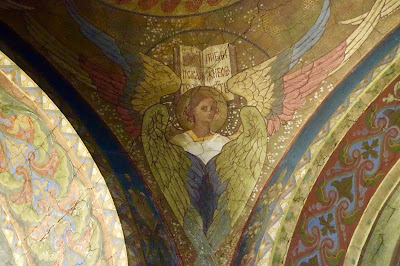 |
| Interior detail, Alexander Nevsky Cathedral, Sofia. |
I began my trip in the capital, Sofia which is just over two hours flying time from London. It is a city that does not have the immediate appeal of say Prague or Budapest but one which grows on the visitor, gradually revealing its delights which include not only the spectacular modernist architecture already referred to, but a superb National Gallery, the iconic Alexander Nevsky Cathedral, some interesting markets and several stylish cafes.
The Cathedral is a symbol of both Sofia and Bulgaria. Occupying a massive site it can accommodate up to 10,000 people. The interior is decorated with Brazilian onyx and Italian marble whilst the main dome is gold plated and stands a towering 45 metres high, with the bell tower eight metres above it. The interior walls are covered with murals depicting various biblical scenes whilst the Lord's Prayer is inscribed around the central dome. The Cathedral is named for a Russian prince, Saint Alexander Nevsky in honour of the Russian soldiers who died in the Russo-Turkish War of 1877-78 which resulted in Bulgarian independence from Turkey. Work began on the construction in 1884 but was not completed until 1912. Russian Alexander Pomerantsev was the main architect. He also designed a church in Moscow of the same name as Sofia's Cathedral as well as several civic buildings.
The city is also home to Europe's largest synagogue although it was not open for visitors whilst I was there. Bulgaria, despite being an ally of Germany,
resisted pressure to deport the country's Jews during the Second World War due in no small part to the intervention of the Orthodox Church. There are a few thousand Jews in the country today, the vast majority having left for Israel in 1949. A small museum, tucked away behind the synagogue tells the story of Bulgarian Jewry.
 |
| Flower stall, Women's Market, Sofia |
 |
| Book themed seat, Book Market, Sofia |
Sofia has a number of markets. Close to the well-kept
Central Market Hall there is a lively street market originally called the Women's Market. Sofia's citizens come here to buy fresh fruit and vegetables, meat and fish, olives, herbs and spices, flowers, household items and cheap clothes. Fruit and vegetable stall holders spray their produce with water throughout the day to keep it looking as fresh as possible and to try to get an edge on the fierce competition with neighbouring traders. There is also an open air Book Market in Slaveikov Square, where the stalls offer an eclectic mix of academic books, second hand novels in Bulgarian and a smattering of other languages, publications to help learn another language and children's books. There are also a few stalls here selling stationery and cheap gifts.
As in most European capital cities, there is plenty to see if you just wander. Sofia's streets provide a stage for many musicians whilst in the City Garden Park during good weather, chess enthusiasts gather to play on the specially designed tables or on the park benches, often attracting groups of spectators and supporters. The more serious players even bring their timing devices with them. Stepping away from the main streets brings rewards too like the fabulously colourful housing unit pictured below.
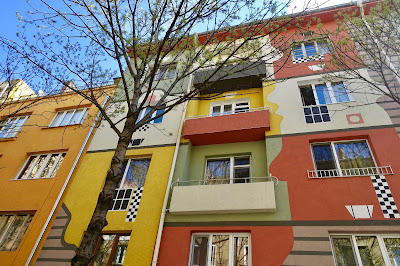 |
| A surprise in a Sofia side street. |
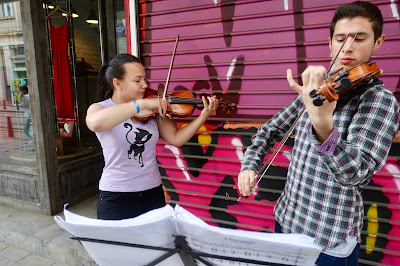 |
| Street musicians, Sofia |
Bulgarian art is little known outside of the country This is a pity as in addition to older religious works, Bulgaria produced some superb artists during the 20th century including
Jules Pascin (often mistakenly thought of as French due to having been part of the Montparansse group) and modernist painters
Vera Nedkova and
Bencho Obreshkov, the latter of whom studied under Oskar Kokoschka. The huge
National Gallery just across from the cathedral exhibits pictures by each of these artists together with hundreds of other works charting the history of Bulgarian art.
The
Sofia History Museum is also worth visiting. It tells the story of the city through displays of objects, photographs and films. Some sections are more interesting than others but the final gallery with its tram carriage, shop signs, advertisements and film of the city in the first part of the twentieth century is great. The exhibitions are to some extent upstaged by the building which was once the Central Mineral Baths. The exterior is especially attractive due to its red, white and yellow stripes and decorative ceramic details.
 |
| Sofia History Museum |
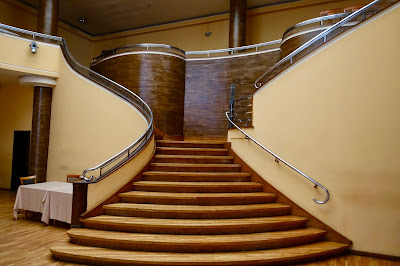 |
| Winter Garden staircase, Bulgaria Complex, Sofia |
I have already mentioned my lack of culinary experiences during my 1986 visit.
Things are very different now. I was even able to find a couple of restaurants specialising in vegetarian food.
Dream House is a small, friendly restaurant with daily specials and some good soups and salads. It is a little hard to find at the top of a flight of stairs in a multiple occupancy building but its worth the effort.
Veda House has an interesting menu with Indian and Middle East influences including good humous (hooray). Regular readers know that I search out good patisseries and bakeries. Sofia has many cake shops but I especially enjoyed my tiramisu at the cafe in the Bulgaria Ccomplex where they also allowed me a peek at the winter garden and its fabulous staircase, deco details and retractable roof. The complex includes a concert hall and book shop and was completed in 1937 to the designs of Stancho Belkovski and Ivan Danchov.
The Rila Monastery is a couple of hours drive from Sofia. Surrounded by the Rila mountains it is a symbol of Bulgaria and possibly the country's major tourist attraction. I visited in April before the main visitor season starts and arriving early in the morning had the place more or less to myself for the first hour.
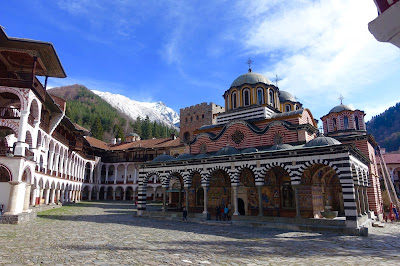 |
| Rila Monastery |
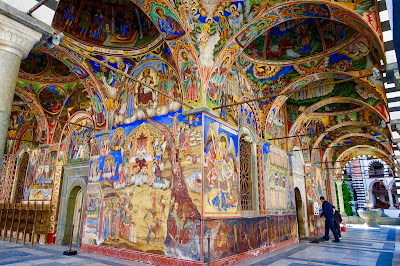 |
| Rila, external murals |
The monastery is protected by austere fortress style walls designed to deter bandits, robbers and others who jealously eyed its wealth during its long history. The walls are the only austere feature of the monastery as upon entering the courtyard, visitors are overwhelmed with the astonishing, vibrantly coloured external wall paintings of the Church of the Nativity of the Virgin Mary, the black and white Byzantine style stripes of its arches and the brilliant white three storey living quarters of the monks. Add the snow capped mountains as a backdrop and you have what must be one of Europe's most beautiful views.
The interior walls of the church are completely covered in frescos depicting the triumph of good over evil whilst one of the external works depicts the various circles of hell as a warning to transgressors. The paintings were the work of Bulgarian artist
Zahari Zograf. There is also a beautiful iconostasis made from walnut, decorated with gold leaf and featuring carvings of flowers, fruits and birds. Photography is not allowed inside the church but you can take as many pictures as you like in the courtyard.
The current monastery was completed in 1335 under the patronage of Stefan Hrelyo Dragovol, a boyar or nobleman, but was named for the hermit Ivan Rilski who founded the original hermitage a few centuries earlier. A major fire in 1833 was followed by significant rebuilding and restoration which included making use of Bulgaria's greatest artists and craftsmen.
The drive from Rila to Plovdiv took three hours and passed tough many small villages where life remains much the same as it has for centuries. It was not unusual to see a horse and cart being used to transport goods and people. The road passes through vineyards and other crops and because it was spring I also saw many storks and their nests perched on top of telegraph poles.
 |
| Varna, by the Black Sea |
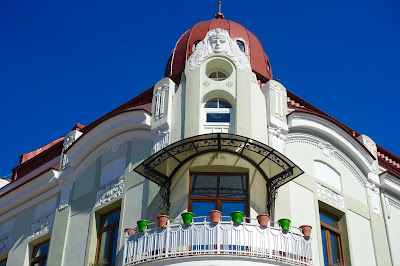 |
| Art nouveau, Varna |
 |
| Art nouveau, Varna |
I visited Varna in 1986. It was supposed to be a day trip with the dolphinarium in the morning (ok not my thing either but my daughter enjoyed it), followed by museum visits in the afternoon. Shortly after entering the dolphinarium torrential rain began and continued for the rest of the day resulting in the other visits being cancelled, so this was the first time I had a proper look at the city. I was not disappointed. Sitting on the Black Sea shore, it has a similar feel to Odessa with its architectural and cultural richness complemented by clean beaches and a very relaxed atmosphere.
A few weeks after my early April visit, Varna's beaches would become crowded with visitors from Western Europe but as with Rila, I had the beach pretty much to myself and although I needed to wear a sweater and light jacket, it was sunny enough to sit outside a beach cafe enjoying the strong coffee and homemade strawberry ice cream. Just to help the local economy of course. My hotel was just a few minutes from the beach across the elegant Sea Garden that separates the city from the Black Sea. Founded as a very small affair in 1862 towards the end of the Ottoman period, the Garden was massively expanded under Mihail Koloni, the first Mayor after liberation. Over the years it has been extended and improved and includes a planetarium, observatory and zoo as well as many cafes, bars and restaurants. Cosmonaut
Yuri Gagarin planted a silver fir there in 1961 in the Alley of the Cosmonauts.
The city's main attraction is the Roman bath or thermae, established in the second century and one of the largest in Europe at more than 7,000 square metres. It is still possible to see the remains of the changing rooms, cold, warm and hot pools and a large social area. The heating was provided by a hypocaust, an underground system of pipes. The baths remained in use for about a century before being abandoned as the Roman Empire faded. During the 14th century, craftsmen used the structures as workshops and today the site is a major open air museum.
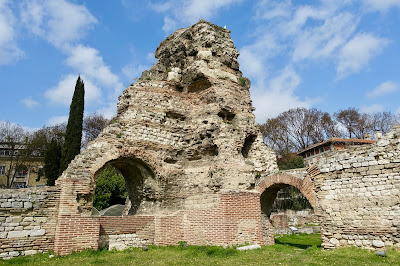 |
| Roman Thermae, Varna |
 |
| Cathedral dome, Varna |
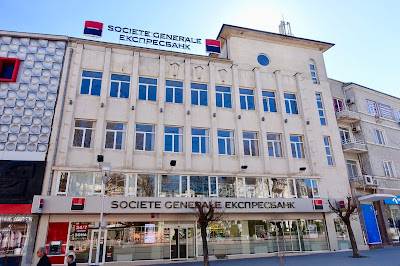 |
| Popular Bank, Varna |
Varna's architectural richness runs from Roman ruins to baroque and Art Deco apartment blocks, some fabulous modernist buildings from the 1930's and of course, the Dormation of the Mother of God Cathedral. The unusual name was chosen in honour of the former Empress Consort Maria Alexandrovna of Russia, a relative of the Bulgarian royals. Completed in 1886, it is one of Varna's most iconic images with its several domes and beautiful interior where, as with Rila, every surface is covered in frescos. And then there is the stunning interior of the main dome with its central Christ figure surrounded by saints against a blue background. Spectacular.
Much as I love the cathedral, my favourite Varna building is the modernist apartment block on Primorksi Boulevard designed by Stefan Benedikt-Popov and completed in 1933. Known as "The Beach" it has the appearance of an ocean liner with long balconies at each level and a squared off tower that continues the nautical theme. There are many other modernist buildings in the city including the very cool Popular Bank designed by Zhelyazko Bogdanov and built from 1938-39, and a charming apartment building in San Stefano Street, the details of which are unknown.
 |
| "The Beach" apartment block, Varna |
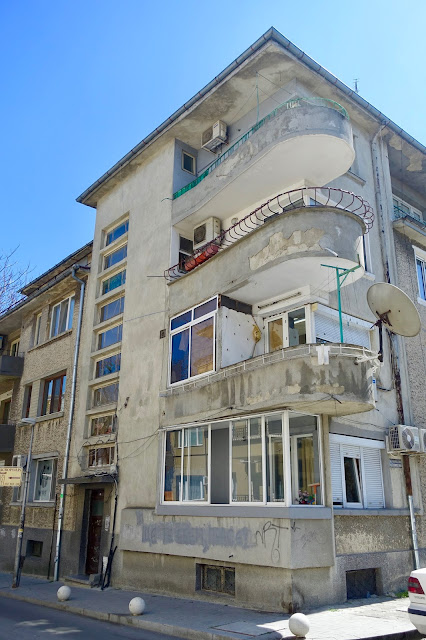 |
| Modernist apartment block, details unknown, Varna. |
I doubt it will be another 31 years before I return to Bulgaria.
You might also like
Bulgarian Modernism - A Well kept Secret or
A Few Days In Plovdiv
You can see more pictures of Bulgaria
here.










